World News
Duchess of Kent dies at 92 the royal who shocked Britain by becoming a Hull school teacher
The Duchess of Kent who once handed trophies at Wimbledon chose a quiet life teaching music in Hull and left behind a legacy of resilience and compassion

When most people remember the Duchess of Kent, they picture her at Wimbledon, elegantly dressed, handing silver trophies to champions and consoling tearful runners-up. But behind the royal image was a woman who made choices that stunned Britain — leaving her royal titles, quietly converting to Catholicism, and becoming a primary school music teacher in Hull, where children knew her simply as “Mrs Kent.”
Born Katharine Lucy Mary Worsley in 1933 at the stately Hovingham Hall in Yorkshire, she grew up in privilege but also loneliness. Her brothers were sent to boarding school, and during World War Two, her mother and governess were often her only companions. Music became her solace. At school, she discovered her voice and learned piano and violin — passions that later shaped her most surprising chapter.
Meeting a Prince
As a young debutante in the 1950s, Katharine was introduced to many of Britain’s most eligible bachelors. One of them was Prince Edward, Duke of Kent, a grandson of King George V. Although his mother, Princess Marina, disapproved of their match — Katharine was a wealthy commoner, not aristocracy — the romance endured. When the duke was posted abroad to Germany, he still found ways to send her flowers across oceans.
The couple announced their engagement in 1961, marrying at York Minster instead of the traditional London cathedrals. It was the first royal wedding at the Minster since 1328, attended by glittering names like Noël Coward and Douglas Fairbanks Jr. Newspapers called her a fashion icon after she posed in a miniskirt just before the wedding.
Royal Duties and Motherhood
The duchess gave birth to three children — George, Earl of St Andrews, Lady Helen Taylor, and Lord Nicholas Windsor — and endured deep personal loss. In 1977, her son Patrick was stillborn, and she openly admitted suffering from acute depression, a rare public acknowledgement for a royal woman of her era.
Alongside her husband’s military postings in Hong Kong and Germany, she represented Britain abroad, including at Uganda’s independence celebrations in 1962. Later, when Prince Edward retired from the Army, she shouldered the pressures of increased public duties. Her health faltered, leading to a period of “nervous exhaustion.”
Breaking Traditions at Wimbledon
From the 1960s onward, she became beloved as the royal face of Wimbledon. She famously comforted a devastated Jana Novotná in 1993 after the Czech player’s heartbreaking loss in the final. Reports suggest the duchess played a key role in modernizing tennis tradition by ending the requirement for players to bow or curtsy when passing the royal box.
Choosing Music Over Titles
But it was her decision in the 1990s that shocked Britain most. Recognizing her twin passions for children and music, the Duchess quietly stepped back from royal life. She took a position at a primary school in Kingston upon Hull, teaching young pupils to sing and play instruments. Staff knew her simply as “Kath,” while her students called her “Mrs Kent.” She even gave up using “Her Royal Highness.”
In 1994, she also became the first senior royal to convert to Catholicism since the Act of Settlement of 1701. For a woman so close to the crown, it was a bold spiritual choice that reflected her independence of thought.
A Life Remembered
Throughout her life, the Duchess balanced duty with humanity. She endured heartbreak, battled depression, broke centuries-old traditions, and chose fulfillment over ceremony. Her legacy is not just in the photographs of her handing trophies to Wimbledon champions, but in the hundreds of Hull schoolchildren whose first love of music came from her classroom.
As Britain mourns her passing at the age of 92, her story remains a reminder that behind the polished titles of royalty, there can be individuals who long for something simple — a classroom, a piano, and the joy of children’s voices.
World News
Massive fire erupts at Chevron refinery near Los Angeles… residents told to stay indoors
An explosion triggered a blaze at Chevron’s El Segundo refinery, the largest on the U.S. West Coast. Officials report no injuries but warn of possible air quality impacts.
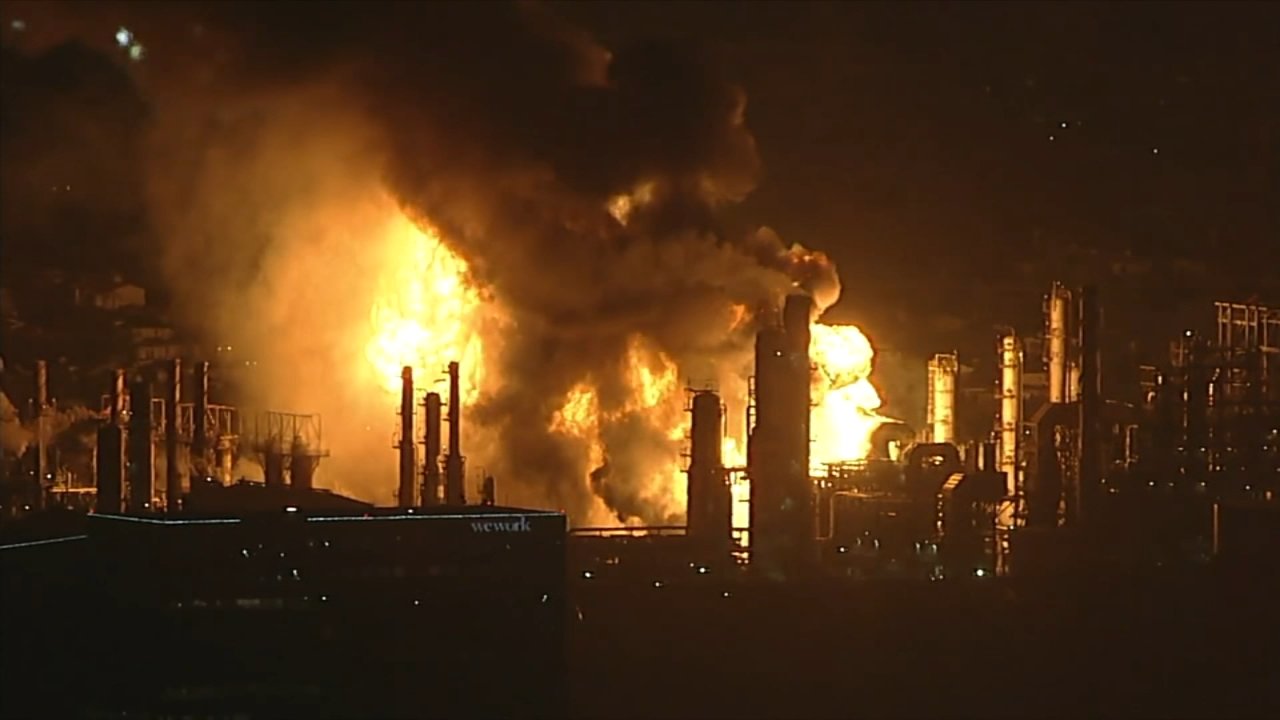
LOS ANGELES — A massive fire broke out Thursday night at the Chevron oil refinery in El Segundo, following what witnesses described as an explosion that “felt like a small earthquake.”
The El Segundo Police Department confirmed multiple emergency calls came in around the time of the blast, prompting a swift response from both local firefighters and the refinery’s in-house fire team. Crews from the Los Angeles County Fire Department and the California Governor’s Office of Emergency Services also mobilized to assist.
El Segundo Mayor Chris Pimentel said that while the fire was significant, no injuries had been reported.
“We were able to respond with Chevron fire immediately,” Pimentel told reporters. “Obviously, we are very concerned, and there is a lot of investigative work to be done.”
Fire contained but concerns remain
LA County Supervisor Holly Mitchell confirmed that crews had managed to contain the fire to one section of the refinery. She assured residents there was no need for evacuation but urged locals to remain indoors as a precaution.
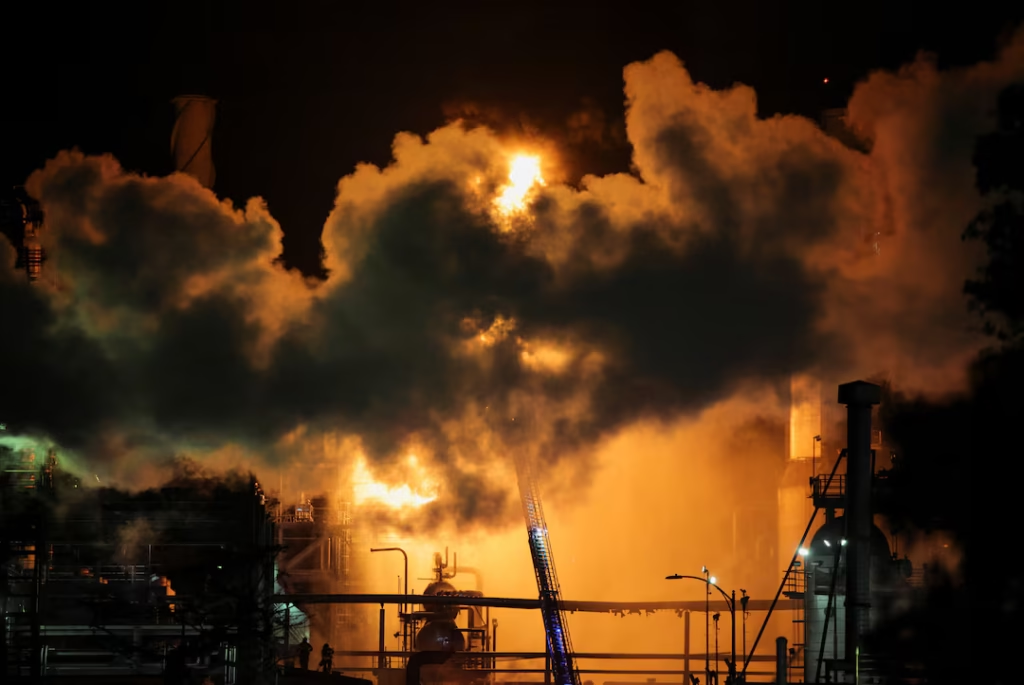
“It has been contained and there is no cause for alarm for El Segundo or the surrounding areas,” Mitchell said, while cautioning that smoke could impact air quality.
The South Coast Air Quality Management District (AQMD) noted that no elevated toxin levels were detected immediately after the blaze. Still, AQMD spokesperson Nahal Mogharabi advised residents to keep windows and doors closed if they noticed smoke or odors.
Casey Snow, Division Chief of the El Segundo Fire Department, confirmed there was no threat to nearby Manhattan Beach and that the burning materials were mostly gasoline and diesel. “The fire will either burn itself out or be extinguished with ongoing efforts,” Snow said.
A refinery of national importance
The El Segundo refinery, built in 1911, processes about 276,000 barrels of crude oil per day, making it the largest producing oil refinery on the U.S. West Coast, according to Chevron’s website.
Its proximity to Los Angeles International Airport (LAX) sparked concerns about potential flight disruptions, but LAX confirmed that operations continued without delays or cancellations.
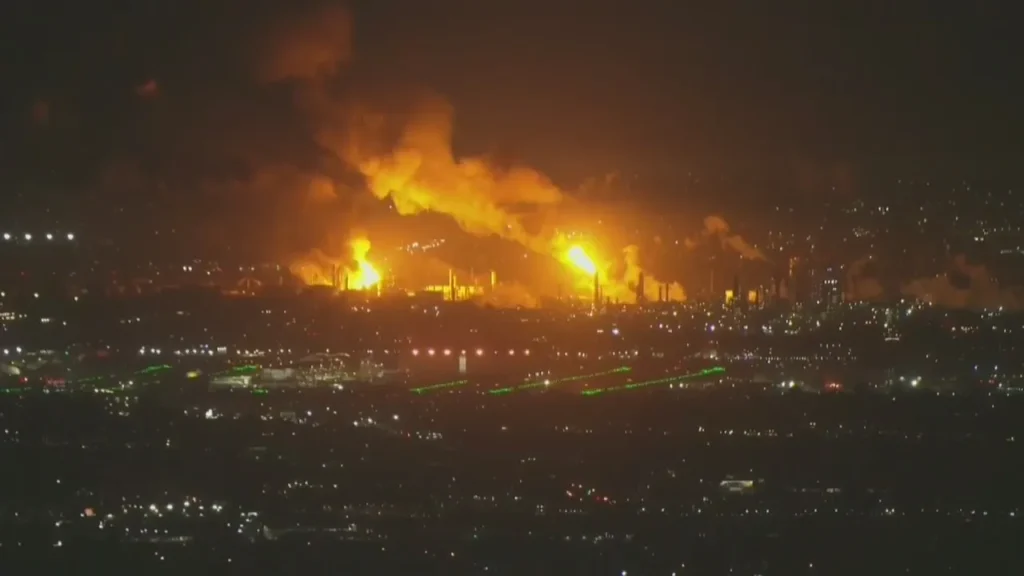
Looking ahead
While the blaze has been contained, investigators are expected to probe the cause of the explosion. This is not the first time Chevron has faced refinery-related incidents; the company has previously been criticized over safety lapses at facilities in Richmond, California, and abroad.
For El Segundo residents, the immediate priority is safety. Officials stress that while there is no imminent danger, smoke-related conditions could shift quickly.
As the refinery’s gasoline and diesel flames die down, questions will linger about what caused the explosion at one of California’s most critical energy hubs — and whether it could have been prevented.
For more Update http://www.dailyglobaldiary.com
World News
Philippines rocked by 6.9 magnitude earthquake as Cebu declares state of calamity and death toll rises to 69…
The devastating quake struck just days after back-to-back typhoons, leaving thousands homeless and rescue teams racing against time.
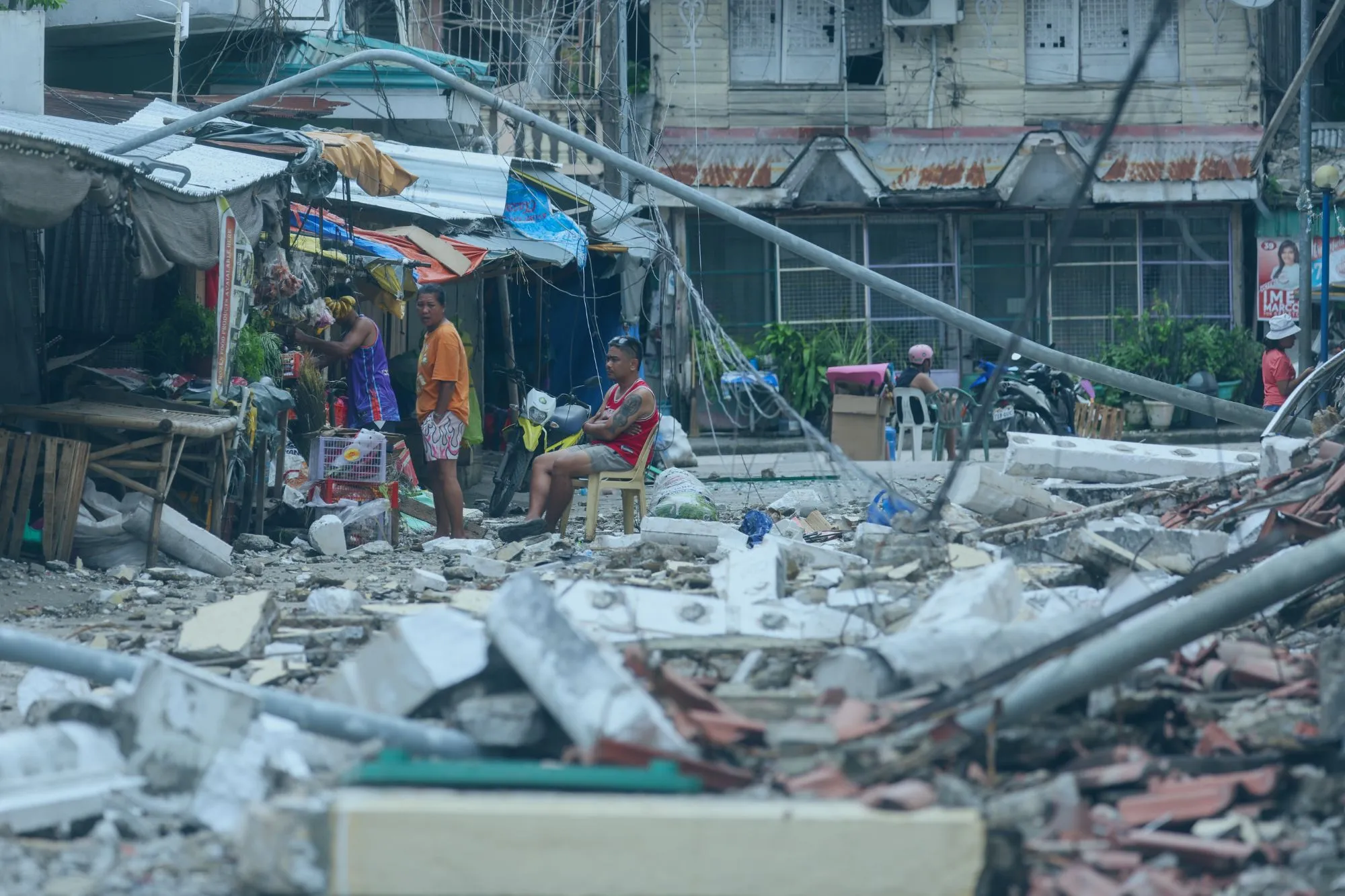
A powerful 6.9 magnitude earthquake shook the central Philippines late Tuesday night, killing at least 69 people and injuring dozens more. The hardest-hit province, Cebu, declared a state of calamity early Wednesday as repeated aftershocks sent terrified families into the streets and crippled basic services.
“Children were crying… people were traumatised”
Eyewitnesses described harrowing scenes. One Cebu resident told the BBC he spent the night outside after power and water lines were cut, adding: “You could hear the voices of crying children everywhere. They were traumatised.”
The earthquake comes barely a week after the Philippines endured two successive typhoons, which claimed more than a dozen lives and displaced hundreds of thousands. The dual disasters have stretched emergency services thin in one of the world’s most disaster-prone nations.
Bogo city bears the brunt
Most victims were from Bogo city, a small town in the Visayas Islands near the quake’s epicentre. Shocking images showed cadaver bags lined along the streets while makeshift hospitals treated hundreds of wounded in tents. Officials warned of “a lot of damage,” noting that roads buckled, bridges collapsed, and power lines fell, complicating rescue and relief operations.
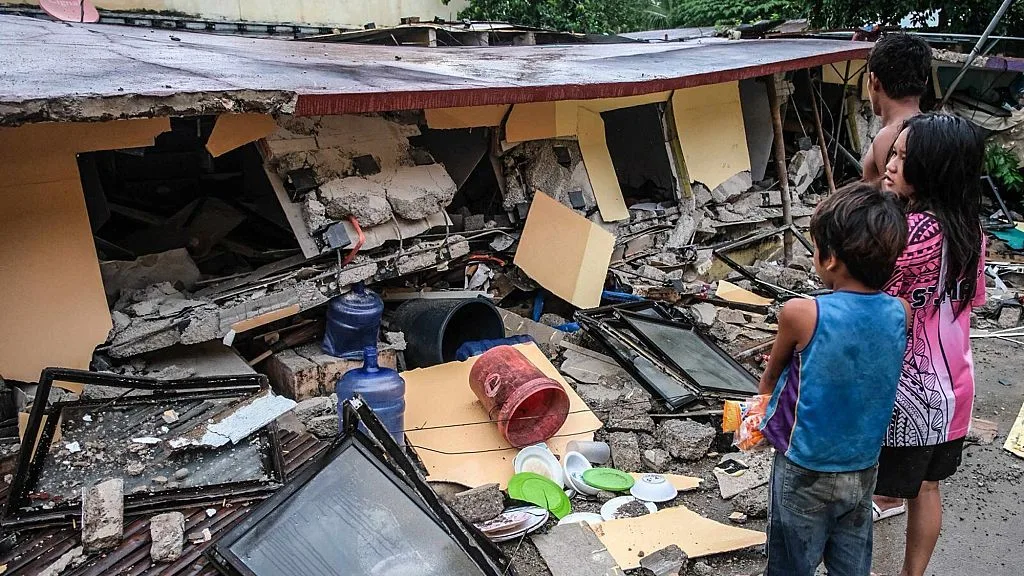
Tragically, seven of the victims were living in a housing village originally built for survivors of Typhoon Haiyan—the 2013 superstorm that killed more than 6,000 people.
Disaster strikes during daily life
In San Remigio, the quake struck while a basketball game was underway, sending panic through the crowd. Nearly 20 people were injured, and at least one later died from their injuries, officials confirmed.
As aftershocks rattled the province—including a 4.7 tremor on Wednesday evening—rescue officials prioritised restoring electricity, clearing debris, and rushing relief goods to stranded residents.
Churches and heritage sites at risk
The archbishop of Cebu urged Catholics to stay away from churches until safety assessments are completed. This warning is particularly significant in Cebu, home to centuries-old churches dating back to the 1500s Spanish colonisation. Footage captured the dramatic collapse of a church tower in one locality.
A nation at the mercy of nature
The Philippines’ vulnerability to natural disasters stems from its geography. Located on the volatile Pacific “Ring of Fire”, the nation is prone to frequent earthquakes and volcanic eruptions. Its position along typhoon tracks makes it equally exposed to devastating storms.
Just last month, Tropical Storm Bualoi and Typhoon Ragasa struck, killing over a dozen people and forcing mass evacuations.

The road ahead
Officials warn that casualty numbers could rise further as many regions remain cut off. The National Disaster Risk Reduction and Management Council (NDRRMC) in Manila is tasked with confirming figures, but their checks are slow and rigorous.
For now, thousands in Cebu and nearby Leyte islands remain without shelter, food, or clean water. Local authorities have appealed for doctors, nurses, and volunteers as the nation braces itself for yet another test of resilience.
For more Update http://www.dailyglobaldiary.com
World News
Thailand Sinkhole 50 Meters Deep Shocks Bangkok Residents near Vajira Hospital
Authorities race to stabilize ground collapse in central Bangkok as traffic, power, and utilities face major disruption.
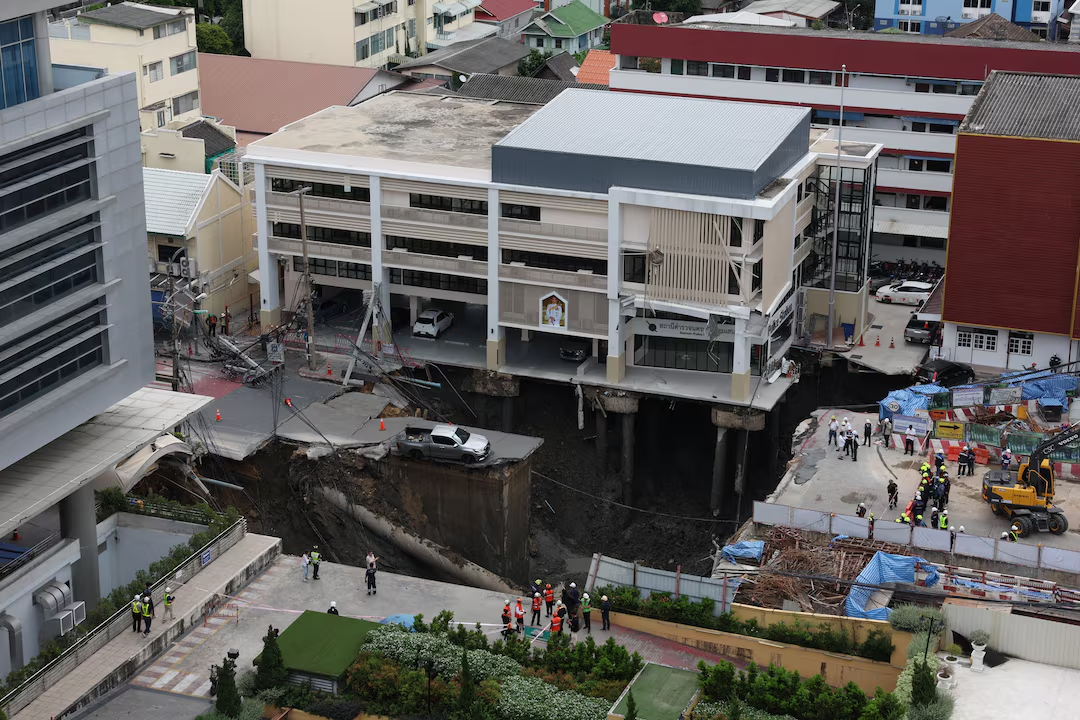
A massive sinkhole opened up in the heart of Bangkok on Wednesday, sparking chaos, evacuations, and emergency operations. The incident occurred in front of the Vajira Hospital on Samsen Road, leaving residents stunned as footage of the ground caving in spread across social media.
According to Thai officials, the sinkhole measured about 50 meters deep (164 feet) and spread across nearly 900 square meters. The collapse dragged down electricity poles and ruptured a drainage pipe, causing water to gush uncontrollably and further weaken the surrounding area. Traffic around the hospital came to a grinding halt as authorities cordoned off the zone to prevent further casualties.
Prime Minister Reacts
Anutin Charnvirakul, the Prime Minister of Thailand, arrived at the site to assess the situation. Addressing reporters, he said:
“Dirt from an underground train construction was sliding in. Luckily there are no deaths or injuries.”
The statement provided relief to residents already concerned about the safety of patients at Vajira Hospital and nearby establishments.
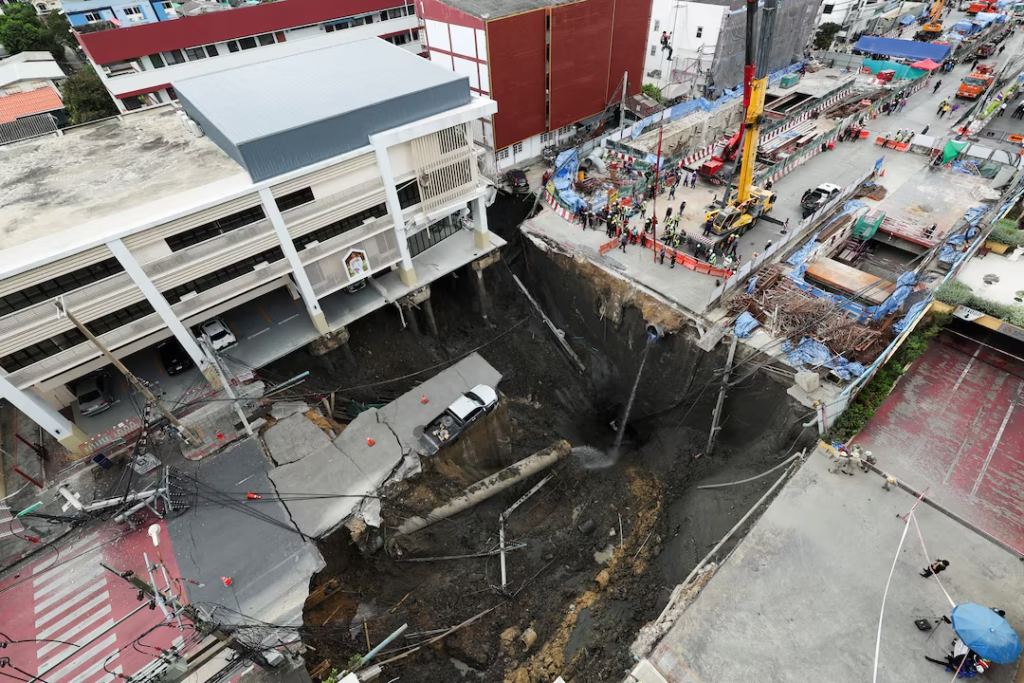
Governor Orders Emergency Measures
Chadchart Sittipunt, the Governor of Bangkok, confirmed that the sinkhole damaged underground infrastructure, cutting off both water and power lines.
“The hospital has no problems, but we are worried about the police station: that’s still dangerous and the public has been evacuated,” he explained.
Authorities moved quickly to ensure the hospital had backup systems in place, though the hospital temporarily suspended new admissions to ensure safety.
Eyewitness Accounts
Residents who witnessed the collapse described the scene as surreal. One local said the road “sank like quicksand” as the drainage system failed. Others filmed dramatic moments where poles and debris vanished into the widening hole.
Social media platforms lit up with hashtags about the Bangkok sinkhole, with many expressing gratitude that no lives were lost.
Possible Cause
Preliminary investigations point to underground train construction as a likely cause. Loose soil combined with pipe leakage created conditions for the ground to cave in. Experts note that Bangkok’s geology, with its layers of soft clay, makes it particularly vulnerable to such collapses when heavy infrastructure is built without reinforced protections.
Past Sinkhole Incidents
This is not the first time Thailand has faced sinkhole scares. Similar incidents, though smaller, have been reported in provinces like Chiang Mai and Nakhon Ratchasima. However, the scale of this Bangkok collapse is among the largest in recent memory.
Authorities’ Response
Sinkholes are not unique to Thailand. Countries such as China, United States, and Mexico have all battled devastating sinkholes in urban areas, often linked to underground construction and aging drainage systems.
By noon, Thai authorities reported that ground movement had been halted. Engineers were closely monitoring the site, while rescue teams stood by in case the collapse extended. Heavy machinery has been deployed to stabilize the soil, and barricades have been set up to prevent onlookers from venturing too close.
Governor Sittipunt emphasized that long-term solutions would involve reinforcing the underground train project and overhauling drainage networks to prevent repeat incidents.
Broader Impact
The sinkhole disrupted not only traffic but also emergency services. With a police station in the vicinity under threat, officials rushed to relocate staff and important documents. Meanwhile, commuters faced hours-long delays, and businesses near Vajira Hospital were forced to close temporarily.
Urban planning experts argue that Bangkok must rethink its infrastructure resilience. With rising rainfall due to climate change, the city’s already fragile drainage system is under enormous stress. Events like this underline the urgency for preventive action rather than reactive measures.
Conclusion
The Bangkok sinkhole has served as a wake-up call for Thai authorities and urban planners. While no lives were lost, the risks remain high until the site is fully secured. For residents, the terrifying images of the ground opening beneath one of the busiest roads in the capital will not be forgotten anytime soon.
Stay updated on this developing story at Daily Global Diary, where we bring you real-time global news and analysis.
-

 Entertainment1 week ago
Entertainment1 week agoAlyssa Milano removes breast implants says she finally feels free and authentic
-

 Technology News1 week ago
Technology News1 week agoChina opens Shanghai digital yuan hub to rival US dollar but here’s the bigger plan
-

 Entertainment6 days ago
Entertainment6 days agoDolly Parton delays Las Vegas concerts by nine months citing health challenges but promises unforgettable return
-

 Entertainment6 days ago
Entertainment6 days agoZoey Deutch engaged to comedian Jimmy Tatro after 4 years of dating with romantic beach proposal
-

 Politics6 days ago
Politics6 days agoBarack Obama blasts Trump over Tylenol autism claim calling it ‘violence against truth’ but that’s not all he said…
-

 Sports4 days ago
Sports4 days agoTottenham’s Champions League wake-up call… why Spurs must stop looking like a Europa League side
-

 Technology1 week ago
Technology1 week agoGoogle shocks crypto world with $3B deal for Cipher Mining stake but here’s the twist
-

 Politics1 week ago
Politics1 week agoBarack Obama slams Trump administration over Tylenol autism claim calls it violence against truth




















